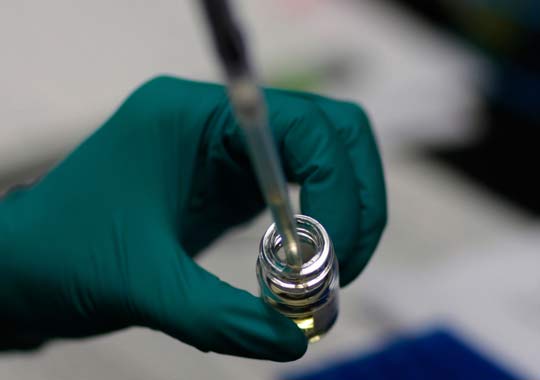Nano vaccines prevent disease
US experts have designed a type of nanoparticle that can transmit vaccines against diseases like AIDS and malaria safely and effectively.
According to Physorg, these nuts can help develop anti-cancer vaccines and infectious diseases. Associate Professor of Biological and Materials Science Darrell Irvine and colleagues at the Massachusetts Institute of Technology are testing the ability of this seed to test the transmission of malaria.
When designing a vaccine, scientists try to stimulate at least one of the two key components in an immune response: T cells, cells that attack infected body cells; or B cells, secreting antibodies that target viruses or bacteria found in blood and other body fluids.

Nano vaccines open hope for AIDS patients. Illustration
For diseases that pathogens tend to stay in cells like AIDS, a strong reaction from a type of T cell called T 'killer' is essential. The best way to stimulate these cells is to use a virus that is dead or weakened but that cannot be done with HIV because it is difficult to turn the virus into harmless.
To avoid the dangers of using live viruses, scientists are working to create synthetic vaccines for AIDS and other viral infections such as hepatitis B. However, vaccines- This application is even safer but does not stimulate very strong T cell response.
Recently, researchers have tested wrapping these vaccines in fat droplets called liposomes, which can help promote T-cell reactions by wrapping the protein into a virus seed. However, these liposomes are very unstable in blood and body fluids.
Irvine expert decided to rely on liposome method by wrapping many fat droplets together in concentric spheres. When the liposomes combine, the contiguous portion of the liposomes is 'pinned' together by chemical method, creating a more stable structure and less likely to be broken too quickly after injection. However, when nanoparticles are absorbed by cells, they decompose rapidly, releasing vaccines and stimulating T-cell reactions.
In tests with mice, Irvine and colleagues used nanoparticles to transfer a protein called ovalbumin, an egg white protein commonly used in immunological studies because existing biochemical tools could Monitor immune responses to this molecule. They found that three low-dose vaccine strains produced a strong T-cell response. After immunization, up to 30% of killer T-cells in mice targeted the vaccine protein. please.
It is one of the strongest T-cell reactions produced by a protein vaccine and is equivalent to a powerful viral vaccine that does not cause concern about the safety of live viruses.
The researchers stressed that it is important that these particles also stimulate a strong antibody reaction.
- 3 common misunderstandings about vaccines
- The US stopped testing HIV vaccines
- Vietnam produces vaccines to prevent new strains of influenza A / H5N1
- Things to know about 5 in 1 vaccines and 6 in 1 vaccines
- There is going to be a vaccine against all flu
- Scientists put nano copper into plant fertilizer
- Harmful misunderstandings about vaccines
- Successfully prepared vaccines against many respiratory diseases at the same time
- Finding a way to prevent influenza does not need a vaccine
- Develop vaccines to prevent autoimmune diseases
- Research on vaccine against black disease
- Detecting contaminated metals and debris in a series of human vaccines
 Green tea cleans teeth better than mouthwash?
Green tea cleans teeth better than mouthwash? Death kiss: This is why you should not let anyone kiss your baby's lips
Death kiss: This is why you should not let anyone kiss your baby's lips What is salmonellosis?
What is salmonellosis? Caution should be exercised when using aloe vera through eating and drinking
Caution should be exercised when using aloe vera through eating and drinking Good news: New cancer drug discovered that causes cancer cells to 'starve'
Good news: New cancer drug discovered that causes cancer cells to 'starve'  Why do we get older when cells are always replicating?
Why do we get older when cells are always replicating?  Shocking Research: Human Memory Doesn't Exist Only in the Brain
Shocking Research: Human Memory Doesn't Exist Only in the Brain  Reasons for easy weight gain: Obesity has 'memory' and retains mechanisms in cells
Reasons for easy weight gain: Obesity has 'memory' and retains mechanisms in cells  What happens to cancer cells after they die?
What happens to cancer cells after they die?  New Breakthrough: 'Hack' Tumors, Turn Cancer Cells Into Pills
New Breakthrough: 'Hack' Tumors, Turn Cancer Cells Into Pills 